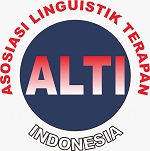Creative Story through 9GAG Application in Teaching Speaking
DOI:
https://doi.org/10.33394/jollt.v9i2.3534Keywords:
Creative Stories, 9GAG Application, Speaking Skills,Abstract
References
Agustina, L., & Setiawan, R. (2020). Fostering a natural atmosphere; improving students’ communication skill in a business meeting. Journal of Languages and Language Teaching, 8(3), 307-314. doi: https://doi.org/10.33394/jollt.v8i3.2746
Aprianoto, & Haerazi. (2019). Development and assessment of an interculture-based instrument model in the teaching of speaking skills. Universal Journal of Educational Research, 7(12), 2796–2805. https://doi.org/10.13189/ujer.2019.071230
Angelini, M. L., & GarcÃa-Carbonell, A. (2019). Developing English speaking skills through simulation-based instruction. Teaching English with Technology, 19(2), 3–20.
Anugrah, N. J., Sumardi, S., & Supriyadi, S. (2019). Integrating “Daily Learn English Application†to Teach Speaking Skill in EFL Classroom. Indonesian Journal of EFL and Linguistics, 4(2), 181. https://doi.org/10.21462/ijefl.v4i2.163
Arends, R. and Kilcher, A. (2010). Teaching for student learning: becoming an accomplished teacher.
Bahadorfar, M. & Omidvar, R. (2015). Technology in teaching speaking skill. Acme International Journal of Multidisciplinary Research, 2(4), 9–13. Retrieved from http://ejournal.radenintan.ac.id/index.php/ENGEDU/article/view/879
Creswell, J. W. (2012). Educational Research: Planning, Conducting, and Evaluating Quantitative and Qualitative Research (4th ed.). Boston: Pearson. Retrieved from https://www.pearson.com/us/higher-education/product/Creswell-Educational-Research-Planning-Conducting-and-Evaluating-Quantitative-and-Qualitative-Research-4th-Edition/9780131367395.html
Hamad, M. (2012). Factors Negatively Affect Speaking Skills at Saudi Colleges for Girls in
the South. English Language Teaching, English Language Teaching, 6(12), 87-97.
Haryanti, D., Indah, R., & Wahyuni, S. (2021). Enhancing oral proficiency using three steps interview technique for eleventh graders. Journal of Languages and Language Teaching, 9(1), 61-68. doi: https://doi.org/10.33394/jollt.v9i1.3271
Hasan, M., Islam, A., & Shuchi, I. (2021). Using mobile-based formative assessment in ESL/EFL speaking. Journal of Languages and Language Teaching, 9(1), 117-125. doi:https://doi.org/10.33394/jollt.v9i1.3449
Irmawati, D. K. (2016). What Makes High-Achiever Students Hard to Improve Their Speaking Skill? Journal of English Educators Society, 1(2), 71. https://doi.org/10.21070/jees.v1i2.442
Isda, I., Purwati, P., & Imran, I. (2021). The effect of using blended learning model on enhancing students' speaking skill in senior high schools. Journal of Languages and Language Teaching, 9(1), 92-98. doi: https://doi.org/10.33394/jollt.v9i1.2921
Izzah, L & Hadi, M. . (2019). Engaging Learners with theInternet of Things (loT): GenZ’s Perspectives. Educational Initiatives Research Colloquium. Retrieved from https://www.researchgate.net/profile/Mohd-Asnorhisham-Adam/publication.pdf
Jatiyasa, I, W. (2019). Implementasi humor dalam pembelajaran di STKIP agama Hindu Amlapura. Jurnal Mitra Pendidikan, 3(1), 65–80.
Khorashadyzadeh, A. (2014). Why to use short stories in speaking classes? International Journal of Foreign Language Teaching in the Islamic World, 2(1), 9–15. Retrieved from https://www.semanticscholar.org/paper/IJLT-Why-To-Use-Short-Stories-in-Speaking-Classes-Khorashadyzadeh/ff11c97ca343c43e0fa4102e5bfc7065828984fe
Kalantari, F. & Hashemian, M. (2015). A story-telling approach to teaching English to young EFL Iranian learners. Journal of English Language Teaching, 9(1), 221–234. https://doi.org/https://files.eric.ed.gov/fulltext/EJ1087083.pdf
Listiyaningsih, F., Rukmini, D., & Sutopo, D. (2020). Digital literacy via readers’ responses towards humor presented in “9GAG memes.†English Education Journal, 10(2), 214–224
Ma, Q., and Sin, C. H. (2015). Teaching young learners English vocabulary with reading-based exercises in a real classroom situation. Porta Linguarum, 23, 125–138. https://doi.org/http://www.ugr.es/~portalin/articulos/PL_numero23/8%20%20MA%20Qing.pdf
Maryam, S. (2020). Utilizing communicative language games to improve students’ speaking ability. Journal of Languages and Language Teaching, 8(3), 251-263. doi: https://doi.org/10.33394/jollt.v8i3.2733
Mazaozi, S. (2013). Analysis of Some Factors Affecting Learner’s Oral Performance
University of Mohamed
http://www.paaljapan.org/resources/proceedings/PAAL10/pdfs/hyesok.pdf
Meliala, E., Purba, P., Panjaitan, L., Doloksaribu, L., & Tarigan, N. (2021). An analysis of English teachers’ creativity in media-based learning at the tenth-grade students. Journal of Languages and Language Teaching, 9(1), 105-110. doi: https://doi.org/10.33394/jollt.v9i1.3388
Mutiarani and Saindra, R. M. (2018). Using Graphic Organizer to Improve Students’ Speaking Skills. English Language in Focus (ELIF), 1–10. https://doi.org/https://jurnal.umj.ac.id/index.php/ELIF/article/download/4499/3192.
Pranoto, B. E., & Suprayogi, S. (2020). Incorporating 9GAG memes to develop EFL learners’ speaking ability and willingness to communicate. IJEE Indonesian Journal of English Education, 7(2), 130–144. https://doi.org/https://doi.org/10.15408/ijee.v7i2.17496
Tunnisa, D., Mahmud, M., & Salija, K. (2019). Investigating teacher’s sense of humor in Indonesia. International Journal of Language Education, 3(2), 99–114. https://doi.org/10.26858/ijole.v3i2.10201
Wisnumurti, P., Setyaningsih, E., & Wahyuni, D. (2021). Digital storytelling in TEYL: a narrative inquiry of a pre-service teacher. Journal of Languages and Language Teaching, 9(1), 1-13. doi: https://doi.org/10.33394/jollt.v9i1.3338
Downloads
Published
How to Cite
Issue
Section
Citation Check
License
License and Publishing Agreement
In submitting the manuscript to the journal, the authors certify that:
- They are authorized by their co-authors to enter into these arrangements.
- The work described has not been formally published before, except in the form of an abstract or as part of a published lecture, review, thesis, or overlay journal.
- That it is not under consideration for publication elsewhere,
- That its publication has been approved by all the author(s) and by the responsible authorities – tacitly or explicitly – of the institutes where the work has been carried out.
- They secure the right to reproduce any material that has already been published or copyrighted elsewhere.
- They agree to the following license and publishing agreement.
Copyright
Authors who publish with JOLLT Journal of Languages and Language Teaching agree to the following terms:
- Authors retain copyright and grant the journal right of first publication with the work simultaneously licensed under a Creative Commons Attribution License (CC BY-SA 4.0) that allows others to share the work with an acknowledgment of the work's authorship and initial publication in this journal.Â
- Authors are able to enter into separate, additional contractual arrangements for the non-exclusive distribution of the journal's published version of the work (e.g., post it to an institutional repository or publish it in a book), with an acknowledgment of its initial publication in this journal.
- Authors are permitted and encouraged to post their work online (e.g., in institutional repositories or on their website) prior to and during the submission process, as it can lead to productive exchanges, as well as earlier and greater citation of published work.
Licensing for Data Publication
- Open Data Commons Attribution License, http://www.opendatacommons.org/licenses/by/1.0/ (default)
This work is licensed under a Creative Commons Attribution-ShareAlike 4.0 International License.
















